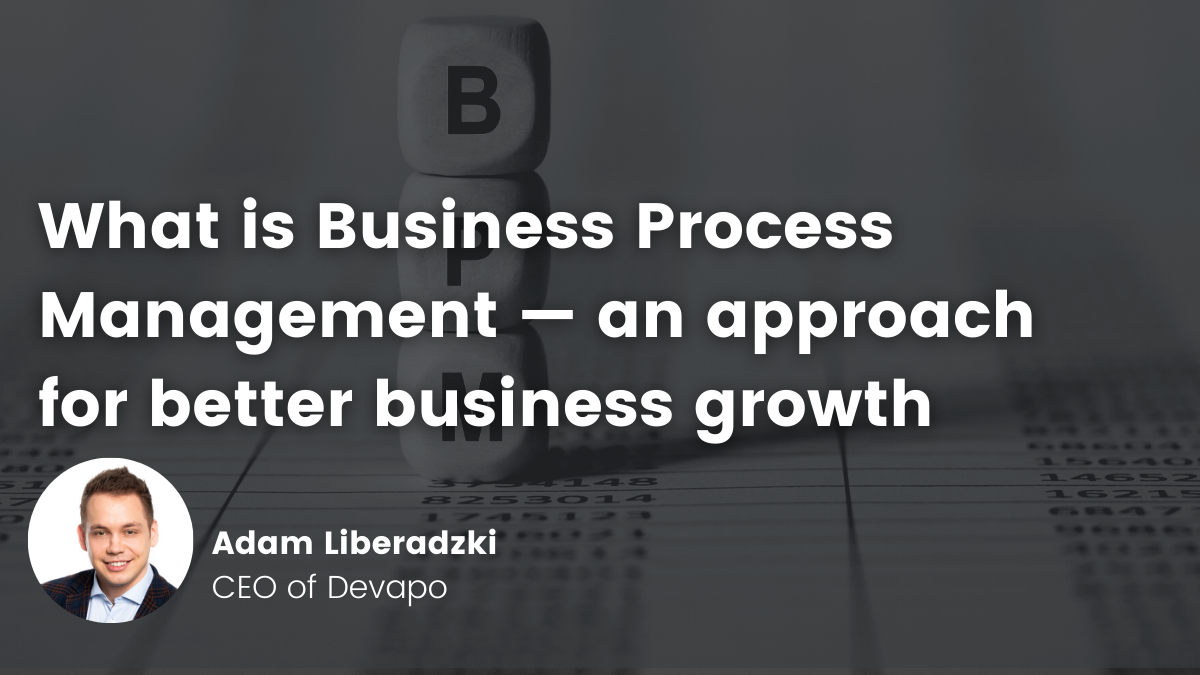- Adam Liberadzki
- Read in 4 min.
All companies deal with certain business processes. Whether it’s the onboarding of new employees, handling customers’ orders, account opening or anything else that is repetitive, these workflows need to be agilely managed to facilitate the tasks for both operators and users.
Often companies do not have a clear understanding of how their processes work. What are the common steps? Who is responsible for what task? What are the outcomes, products or artifacts that should be delivered? Are there any deadlines? What is the top priority now? These types of questions indicate the need of managing business processes. But what is business process management exactly?
What is business process management (BPM)?
Business process management, aka BPM, is an approach for companies that helps control company repetitive operations in real time, so the employees can respond quickly to changing situations. It also allows collaborating on projects and share information easily among teams.
Business process management (BPM) is crucial for business growth, regardless of the company’s size. When combined with the right set of tools and integrated into an IT strategy, it can significantly improve operational efficiency. Below we include a quick high-level introduction to managing business processes.
Business operations management should be seen as one of the core organizational tasks. Being able to look at all processes collectively, as well as individually, allows you to discover various dependencies and bottlenecks that can be improved. It all adds up to creating a more productive and streamlined workflow.
In short, to answer the question of what is business process management, we can say that it is a methodology that helps an organization shape, operate and evaluate predictable business processes.
What is business process management added value for your company?
In organizations, especially in large corporations, process activities are divided into smaller sections, and most people see only one part for which they are responsible. Only those in management positions control the full funnel, knowing how one task affects another and what are the bottlenecks.
By applying business process management to your organization, you increase the chances of:
- Exclusion of errors and operational mistakes, thanks to automation of the most repetitive tasks.
- Saving time on task execution, thanks to the ordering of each step, which improves efficient work.
- Improve communication between co-workers, thanks to easier access to information.
Organizing processes is also a great opportunity to save costs and speed up operations.
Do you really need business process management if you apply project / task management?
Sometimes when we start working with clients, we are asked if it is worth it for them to focus on the bigger picture, as they are already using task management methods for each project.
Therefore, one thing needs to be clarified. Business process management (BPM) is something different, bigger from task or even project management.

Let’s start with the smallest term – task management. Tasks mostly represent work of individuals which is usually a one-time activity and when meets a specific goal, it can be completed.
Project management however is divided into tasks and requires leading entire teams to deliver the final product or outcome. It can be completed when all the tasks that build a project are successfully accomplished.
However, business process management has the widest scope of these terms. It provides direction for organizing all work according to a predictable pattern. Depending on how many processes occur in a company, there may be many bpm introduced to your workflow.
All three terms complement each other, but not really compete with one another. Actually, the BPM tools, project management (PM) tools, and task management (TM) tools are often being integrated to create synergy.

What is Business Process Management lifecycle? Discover 5 steps
Business operations management as the main driver of work, it has defined an iterative lifecycle to continuously automate, monitor and improve processes. Let’s review it.

Design
Processes are usually triggered by some action, schedule or business event. Most of them orchestrate communication between different parties. There is always some defined workflow and some business outcomes. On top of that, there are some business owners of the process who want to improve it in order to managing business processes better. Building basic understanding of the process structure with the stakeholders must be the first step to BPM.
Model
The next step of creating a proper business process management (BPM) system should contain the presentation of the process in a visual layout with formal executable definition. Even exists BPM notation, which is the industry standard in defining the business processes – BPMN.
Execute
Managing business processes can be executed by running it on some process automation engine (i.e. Camunda). Good contractor who will implement the BPM to your company will also take care of restricting access for certain people to some sensitive information. Everyone should have an overview of the process so that communication within the company is clear, while not everyone should have an insight into every piece of information. Before making the process available in the company, it is a good practice to test its functionality on a small control group. This should be standard, and you are unlikely to have to worry about it if you use a service that implements the process for you.
Monitor
The implementation of a process alone is not the end of the work on it. Both benefits and bottlenecks may not be apparent until long after the implementation is complete. That’s why it’s important to observe the process as it unfolds in order to gain management information.
Optimize
As you evaluate the process, analyze and monitor it, you’ll notice improvements that need to be implemented to your workflow to make it more efficient. Consider all process steps. Maybe redesign would be useful? Process engines can often support versioning of process definitions.
What are the three types of business process management?
BPM can be deployed in different versions. Some tasks can be fully automated, others must include some manual verification, but with automation backup. This is why, based on their nature or the purpose they serve, there are various types of processes that are usually being automated in the industry:
Document-centric process
In this process, the focus is directed at the document. It could be a budget table, a contract, or any type of document that needs to be edited and approved in order to decision-making. It is a useful type of bpm for companies that rely on documents, such as insurance companies (e.g. accident form filling) or banking (loan agreement review).
Human-centric process
Significant human input is required in this type of process. Its purpose is to control and approve the various stages of the work. However, some automated functions are implemented to support this. An example of such a process can be a verification of submissions.
Integration-centric process
IC BPM rely on the implementation of existing systems (e.g.,HRMS, CRM, ERP) to reduce human work and rely on automation to transfer information. These kinds of processes are used widely in the finance sector, where it helps to track the numbers across companies.
Some business process management systems will be able to incorporate element of these, but each one will usually have one specialty. There are also some systems that provide flexible means for development teams to customize the process engine.
Summary
I hope that our answer to the question of what is business process management has made the concept of BPM closer to you. The solution brings tremendous value to your company, so it’s worth being aware of it. Let’s remind you of some of the benefits of using BPM in your company:
- Gaining a greater overview of what your processes look like
- Identifying obvious areas for improvement
- Identifying process areas that are chaotic and unwieldy
- Creating, mapping, analyzing and improving business processes
- Increase operational efficiency
- Perform daily tasks more easily
- Move toward digital transformation
- Gain insight into the measurement of KPIs and SLAs
- Accurately track individual items as they move through the workflow
We have published a few articles describing this argumentation more thoroughly to give you some ammunition to sell the idea to the decision makers inside your company:
When should you consider using BPM?
Check out our smart process automation services
Let us help you unlock your business operations efficiency







